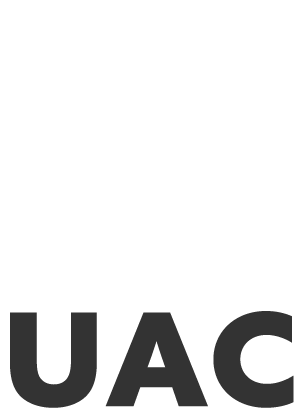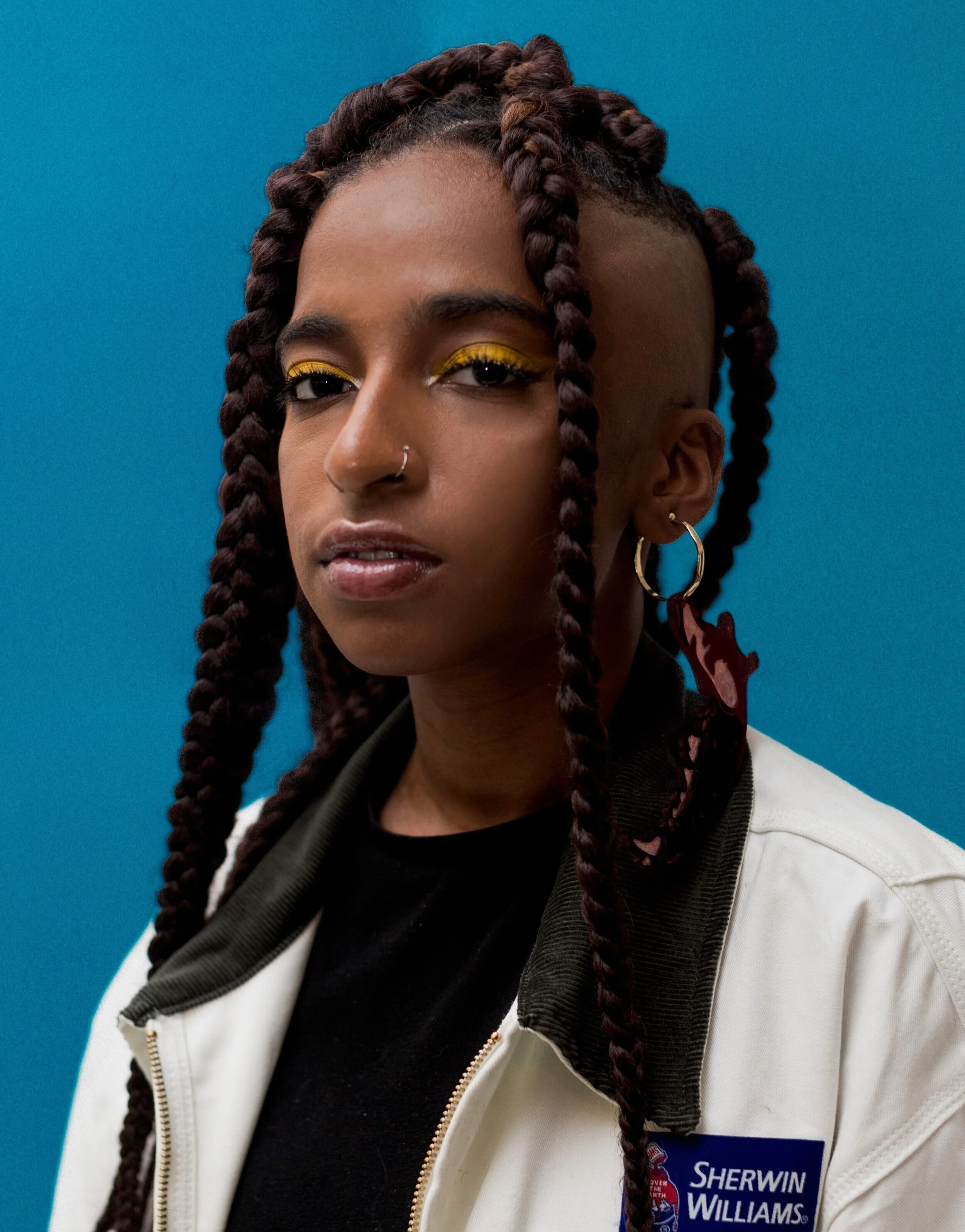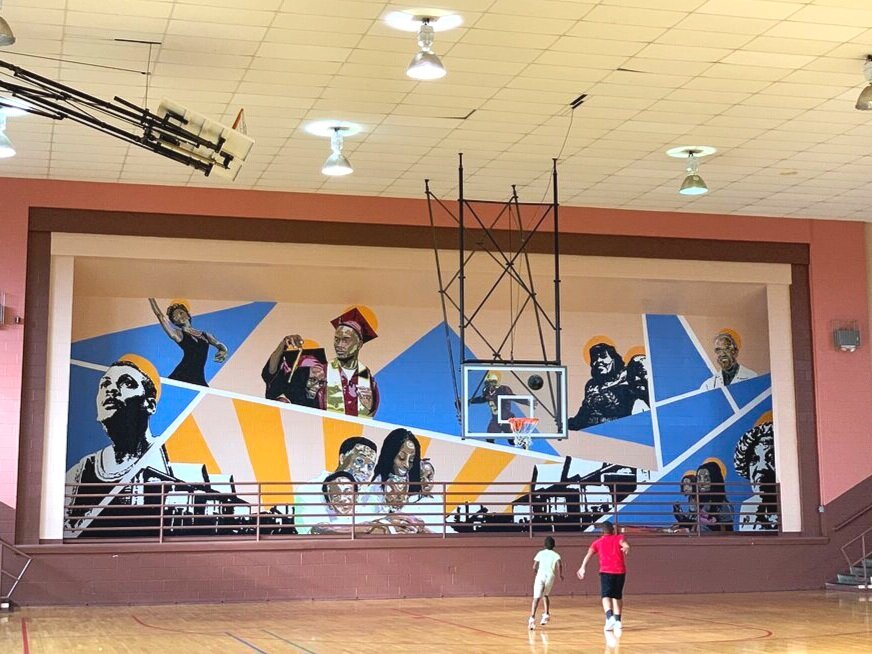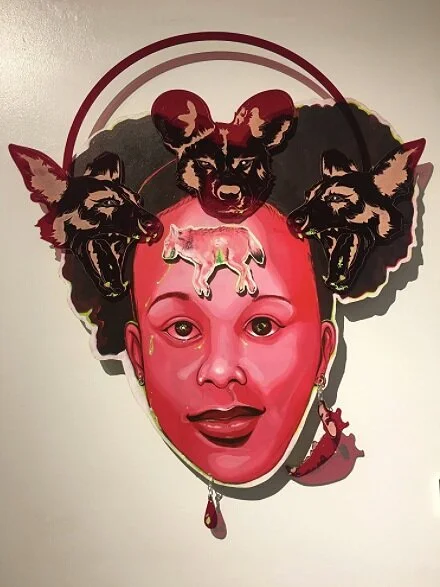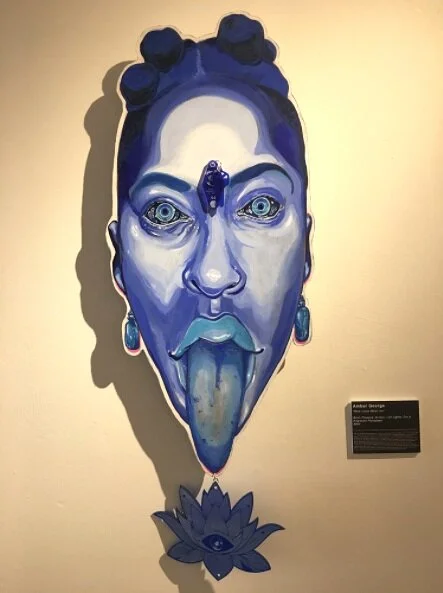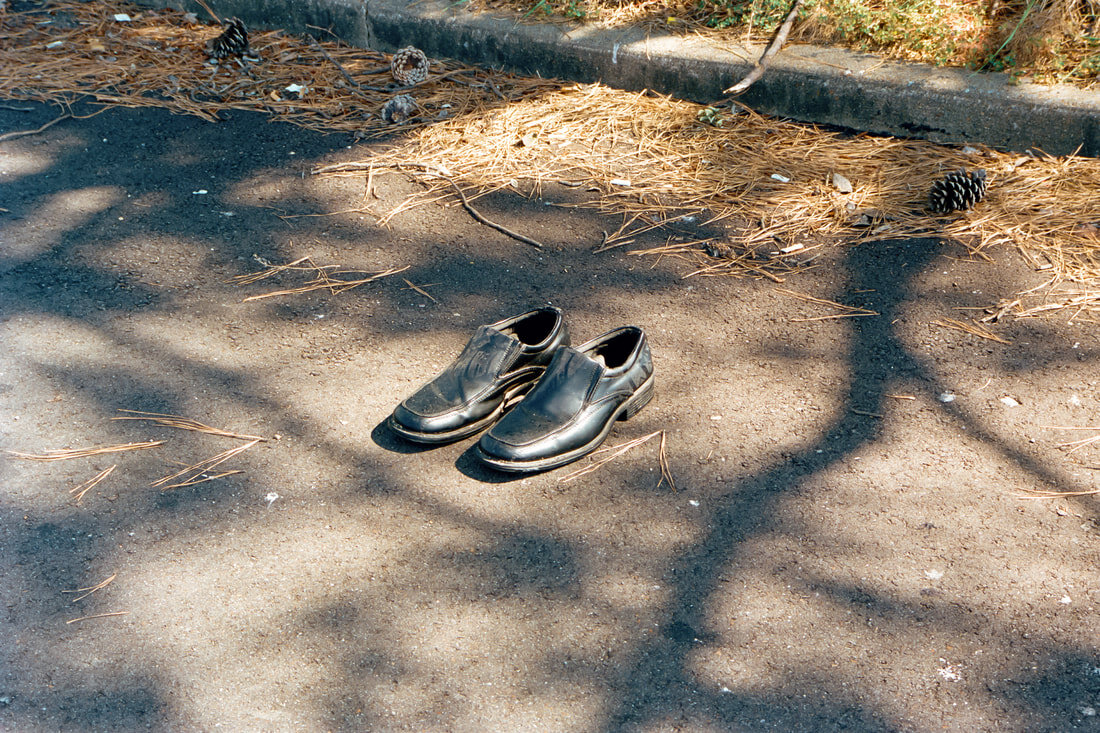Amber George and Lawrence Matthews are local artists who are working together to complete the Welcome to Whitehaven Mural Project. We recently had the chance to chat with them about their inspiration as artists and their upcoming works with UAC.
MW: What inspired you to become an artist?
Amber George
AG: “One of my earliest memories of art in my life was me drawing a picture for my uncle and him telling me that it was terrible. I would draw every day, but I didn’t have a fire behind it yet. That set a fire behind it. I started my artistic career through high school and Memphis College of Art (rest in peace). It seems that spite is a lot of things that fuel my art. Art was therapeutic in that I got a lot of my anger out. Now it has recently just transformed into a very healing thing. I came out through my art, worked through some of my abuse and past trauma with my art. Art now generally makes me happy because I’m doing it about things that I love. Hate runs out, so I’m not out in an ocean without a paddle with it.”
LM: “Mine is kinda the opposite maybe. I was always drawing. I think I maybe drew more exceptionally than the folks in my kindergarten class. I got special attention early on, and I just kept doing it. It was just always one of the things I did, draw and make art. We were always making stuff. We had things, but maybe not all of the things growing up, so we got really creative in terms of having fun and making things like little short films with action figures. So we were always playing with stuff, whether it was drawing, playing with musical stuff, or playing with film stuff, like cameras and cam recorders. So I did all that growing up, and as I got older I started taking it a little more seriously. And then I went to college for it but then didn’t think I could continue college because everyone was so advanced and all I could do was draw. I also make music. I was a studio art major, so I did photography, painting, and sculpture. Always being creative. It’s still that way, I'm always making stuff. It doesn’t matter how it comes out, I’m just going to be doing it.”
MW: How did you start working together?
Orange Mound Community Center Mural
AG: “We met through the organization we work for, The Collective. I started a residency there at the end of 2018. We met through that really softly because we did a small temporary public artwork for Explore Bike Share. We had to do two murals—his was in a shopping center and mine was right next to Melrose High School, which was a really dope project. So we softly met with that, but then he had a mural for UAC in the Orange Mound Community Center, and that’s when we really started working together four times a week. Lawrence was like ‘you paint really good, help me work on this project and I’ll pay you.’ Everything happened after that. Friends, friends, all the things. That was the gateway. That spurred us applying for these other two mural projects because it worked so well. He’s really cold at the admin side, and I appreciate it because I personally have not mastered email or response.”
MW: Why were you drawn to doing public art?
LM: “So there are two sides to it. Financial, because you make more money doing public art if you continue to do public art. Maybe then you might sell things in a certain market—in the city of Memphis, the painting market is what it is. But then on the other side of it is my activism and my work with the community. So for me, public art was a way to reflect neighborhoods back onto themselves in a prideful and community-driven way.
Lawrence Matthews
I also could empower, mentor, or pay young people to work on the projects with me. That was my whole thing and still is my thing, doing that with those kids who are interested in art but never made a dollar from art. The kids who maybe can’t go to college or believe that they can’t go to college for art are able to be a part of this process or this piece that is bigger than them. They walk past it every day and are able to tell their family and friends that they did it. And that builds pride, like ‘oh like you can do this. You’re doing it now in middle and high school. You made money off this thing.’ Then there’s nothing but positivity around the idea of you, as a black kid, making art. Then you’re more likely to pursue it. Like for me, I got a lot of ‘you won’t make money off of this but you’re really really good at it.’ The ‘you’re really really good at it’ kept me going. Seeing my work in different contexts made me feel like I could do this seriously if I wanted to—I just needed to take it seriously. And so I’ve been trying to do that with public art. All the projects I apply for are community-driven. I get to work with the community or young people and be able to pay them through the process. Those are all things that I am very much interested in. And giving back in terms of beautifying. I hate that word, but that’s the thing. I wanna go in neighborhoods that may not have the opportunity to have big giant public art pieces and get their opinions to figure out what they wanna see and what makes them feel good about where they live. You put that there and then step away.”
AG: “It’s kinda split into two for me because I grew up around graffiti, especially throughout college. So public art has this prideful connotation and was very much about presence and how much presence you could make up. So I wasn’t really into public art at first until I was introduced to the notion that I could positively influence a neighborhood’s aesthetic with them in mind and with them collaborating. I think that’s the best thing I learned from my first public art project with the Melrose kids. They were super excited about it. They didn’t have a lot of outlets. This was a resume builder, and they got paid and could let out the passion they were being denied through day to day school stuff. And now I see public art through that lens. Even if it’s not community-driven, I still really enjoy it because now I know so many muralists and especially women of color muralists. You’re being surrounded by all these varying figures from multiple places with so many stories, and it’s a very interesting field.”
MW: What themes are most crucial to your work?
Amber George, Wolf Hunt, 2020
AG: “Representation. And other than that, design. I think the neighborhoods we install in don’t get greatly designed things if that makes sense. People aren’t investing in those neighborhoods like that. My art is really streamlined and really pretty, you might say, so I focus on that and then include the presence of them so they see themselves in that. Other than that, for personal work, healing, self-destruction, the presence of things I love in me in an environment that is usually timeless, surreal but grounded—like a fever dream, when you get delirious before you have an allergic reaction.”
LM: “So for my personal work, including my photography and music, I focus on surrealism and representation in terms of stories or perspectives that maybe don’t get told as often. Social commentary is a thing, too. At least in my photography, it’s subtle, but it’s there— that's the reason why it’s being made. Process is a big thing. Like, being immersed in process for however long it takes to make a thing. It can be a two-minute song and take two months… or two years. And honesty. I think honesty is a big big thing. As of late, within my honesty, trying to be thoughtful about the story I’m telling and who is being included in that story. That includes my film work, too. I would say with public art, representation has been the main thing for me. For us, being a vessel for the things the neighborhoods want to see to feel good about their community. But then us making sure the representation of it is well rounded, whether that be design, or through just being thorough.”
MW: The Orange Mound Community Center Mural and Welcome to Whitehaven Mural are so site-specific—how did you familiarize yourself with the area?
Orange Mound Community Center Mural Detail
AG: “I grew up the first four or five years of my life in Orange Mound because that’s where my great Aunt Ruby lived on Marianna Street. I would go to her every day and take trips with her in the community or visit her friends’ houses. So I was always growing up there, even though I didn’t realize how much time I really spent there until I was older. I came and started working for The Collective in Orange Mound which has been completely full circle for me in that regard. I have family that populates the area and have always been Orange Mound adjacent.”
LM: “I’d been through Orange Mound a whole bunch, but I hadn’t spent time there until we started working with the Orange Mound Gallery (OMG) and the CMPLX, which is obviously in Orange Mound right next to OMG. Before that, we were doing some programming with OMG. I knew certain people within the area from my work, but I started getting familiar with the neighborhood by working with Melrose and running the gallery through CMPLX. For me, for Whitehaven, my mother’s side is from there. The way that Amber described her Aunt Ruby is the same way I was with my grandmother. When I was a little kid, before I started going to summer camps and stuff like that, I went to Whitehaven. All of my cousins were out there, along with my aunts and uncles. Anything that was family-related happened in Whitehaven up until COVID. My birthdays happened out there, and we still do mini birthday celebrations for each grandkid or cousin every year. I’m in Whitehaven many times throughout the year.
Welcome to Whitehaven Mural Concept
For me, it’s super super full circle because I’ve always wanted to do something in Whitehaven because of that. My grandmother passed in 2012, and since then, I've always wanted to do something for her or for the neighborhood. Something that all of my family could drive by and see. Whether it was a billboard or something, I’ve always had dreams and visions of releasing a project or working on a public art piece that my cousins and aunts could drive by and know that I did it to honor their neighborhood and the influence it had on me as a young person. That side of my family has been the most supportive of me doing anything in the arts. Whenever I come by there, they have newspaper stuff of me. They have pushed me to be who I am today. So, to be able to do something there, that is right down the street from my grandmother’s house is very special to me on an emotional level and I’m very grateful for that.”
MW: These areas have rich histories and lasting pride in their roots. How does your work interact with the past, present, and future of the area?
Welcome to Whitehaven Mural Concept Detail
AG: “UAC gave us a list of all the things they wanted us to include. And then we dug a little deeper past those and got into a lot of the history of the schools, reconstruction, and agriculture to make sure it was properly represented. So yeah, it was a lot of research accompanied by symbols and black presence.”
LM: “I think that there’s a weaving of the past and the future. Some of the design elements may change because we’re doing revisions right now. But we set out to create a symbolic history of schools, agriculture, and music by pointing towards things that have been there, but then also including the marching band and that kind of stuff too. So there are modern things, but then there is also a guitar and older musical history. A lot of juxtaposition between the two.”
AG: “We try to be as non-cliché as possible with the imagery. I feel like usually when people get projects like that, they do the bare minimum of representing the neighborhood with a blatant thing that is not representative of the neighborhood or is only a small aspect of the neighborhood. That can be detrimental to it sometimes.”
MW: Why do you think it’s important to invest in public art?
AG: “People like living in nice aesthetic environments. I think it has a psychological effect on you. It builds how much pride you have in your surroundings, and I think people deserve to live in nice spaces. Especially spaces where they get to have input and see themselves reflected in places other than just their house. I think that trickles down to the empathy that folk have with their neighbors. Like, I feel like I live in a very disconnected neighborhood. I don't really know anybody in my neighborhood or anything and that affects my level of care for the surroundings. I could move and feel nostalgic for my house, but not my neighborhood. I feel like public art builds an environment to foster.”
Lawrence Matthews, For Sale, 2019
LM: “That’s how I feel about it, it’s definitely a psychological thing. Like you know that was the whole reason I got into public art. If you have large scale representation, like beautiful, professionally created representation of yourself, your neighborhood, and your community, then you take pride in your community. You take pride in the people who look like the people in the mural who also look like you. You know what I’m saying? That's the thing, you’re less likely to be uncaring of the neighborhood and the people in the neighborhood. There are a lot of systemic and systematic issues within black communities and communities of color, but then there’s also this intense pride in certain neighborhoods. When you look at those neighborhoods, it usually comes from their history. If you look at a neighborhood like Orange Mound or South Memphis and you go back 50 or 60 years to what that neighborhood looked like and what it meant for the people there, the black businesses, the economics, the art, and the music reflected the people who were there, the venues, everything. You fast forward, and that’s not necessarily the case anymore. It has pockets of it, but the pride of certain neighborhoods has been sucked out. So one of the main reasons I was into public art was to help make that pride a thing again. You see old photos of certain neighborhoods, and you see the hand-lettered storefronts and paintings on the sides of buildings that have now faded away. We see the faded versions of those things that the neighborhood was doing itself already.
“It stays with you. It definitely stays with you. Especially when you’re a child, and you grow up with [representation] always being a presence, it creates security.”
Now, technology has advanced, the art forms have advanced, and maybe that isn’t the way people are doing it anymore. I think of where you live, Amber, and there is no public art in Hickory Hill. That is something we talk about all the time—there is no public art in Hickory Hill, other than the precinct on Mount Moriah. That’s the closest it is. There is nothing else. Not an art gallery, not a music venue, nothing. It’s a dry area. When there’s nothing for folks to fall into, they fall into other things and there is no sense of pride. I think, for me, going into a neighborhood or community like Brooklyn or Philadelphia where you see the big giant Jackie Robinson you see the giant Harriet Tubman in Philadelphia—you see all of these things that represent the history of the neighborhood, the future of this neighborhood, and the people that are in it currently. That creates some level of pride. It creates a pride that you know stays with you.”
AG: “It stays with you. It definitely stays with you. Especially when you’re a child, and you grow up with that always being a presence, it creates a security that I feel like a lot of them don’t get because they have to go elsewhere to see those things. Especially working with those kids at Melrose who don’t feel like they have a solid home base. All of the people couldn’t wait to leave in some form or fashion.”
MW: What have you taken away from the experience of creating public art so far?
LM: “Experience, that’s the thing for me.”
AG: “Mostly experience, and just advancement to make better projects and further streamline how we do public art projects. I guess to make sure that the reach is very wide. I want to be able to complete public art anywhere I want in the future. The grants are dope, but I wanna be able to touch any place that I feel like needs some loving if that makes sense.”
Amber George, Blue Lotus Motor Inn, 2020
LM: “I think of it in a way like Hank Willis Thomas. It’s like navigating public art and public spaces. Inserting sculpture pieces in different places—he has two here, but he also has them all over. I like the way that he’s able to do that. I saw one of his pieces in Times Square, where he has a big giant confederate silhouette of a black guy on his horse and set it in the middle of the square. I enjoy the aspect of being able to do things anywhere. But there are steps to being able to do that, right, like for me it was doing a few thousand dollar smaller commissions, temporary commissions, and trying to make sure I do a good job and make sure I'm navigating the process the right way so I can eventually be trusted with more responsibility. You’re trusted with more responsibility, more finances, more resources. And so I just wanna keep building on the resources that are available to impact communities with art, essentially. And so also meet people who also want to do those things and bringing them along too. You know, like how Amber and I connected. I want others to be a part of this and to be able to help them be able to do it on their own. I like that aspect of going to a place where you might be so well known, so trusted with your resources and your ability, that you can contact a city about doing a piece and they would be open do you doing it. I like that Hank Willis Thomas is doing that. I don't even know if he’s making regular art anymore or just big public art pieces or big installation pieces. I’m very interested in that as an artist.”
MW: Who and what inspires your personal work lately?
AG: “Lawrence Matthews. *Lawrence laughs* Sorry! So my timely ones are always Frida Kahlo, always Keith Herring. And then yeah, Lawrence Matthews, because my art is indicative of the proximity that I have to a thing. He’s just a really great artist in a lot of avenues like you can see. So, that’s been my inspiration. I’m actually painting a huge 5x7 portrait of him right now. So yeah, those are my top three.”
Lawrence Matthews, Poof, 2019
LM: “I basically have the same kind of answer, in terms of where my inspiration is coming from as of late, for the music I’m working on. This person right here, among other things for sure because all of my art is at least—at least all of my musical art—is informed by my proximity to people, my relationships, my friendships, my partnerships. They’re all informed by that stuff as well as the world. So, I would say the world is definitely a thing. And the state of it, whether that be our world or the world in general, you know what I’m saying? And then also, in terms of maybe artists, I’m just thinking music stuff because that is where my brain is right now. I’m always just trying to tell stories in more interesting ways. People like Frank Ocean do that. I’m always inspired by him. But also Moses Sumney, Bon Iver, Radiohead. Anybody who's using surreal visuals at this point I’m soaking up a lot of. Whether it be in my photography or in the visual information in the music, I’m just looking at different ways to see myself and the world around me. I am a very literal person at times, very like “this is exactly what this thing is.” I’m trying to break away from that and abstract my storytelling more, abstract my art more, that is the big thing. Abstraction and surrealism. Partners and partnerships. Love and all these things. These things are what’s fueling my creativity at the moment.”
MW: What’s next for you as artists?
AG: “Definitely more public art, and we’re gonna be tackling a lot as a team because we just work. We work together. But individually, I’ve been trying to come into a retail space selling merchandise, branding myself, doing huge paintings, and having a solo show. Hopefully, I’m going to have a show next year given the pandemic and all. I’m just trying to learn whatever I can right now since everything is real slow. I feel like everything is on pause, too.”
LM: “For me, building the team and doing more public art, and then also teaming together on personal work and assisting each other in those processes. So, all the ways that I can help Amber do all the things they need to do. For me, it’s a lot of music, probably more music than anything else. And then public art, I’m always holding a space for public art for sure and continuing my photography work. I took a break for filmmaking for a minute, I don’t know how long that will be. I’m working on this series that I showed at the Dixon at the top of the year. I’ve been building over that series over the year. I want to do some things with that work, in terms of taking it national. Some of the pictures have been put in some really dope collections, so I’m hoping to continue that and hoping to make music on a big scale soon.”
Amber George
Instagram: @damnbamb
Website: damnbamb.co
Lawrence Matthews
Instagram: @donlifted
Music: donliftedmusic.com
Website: lawrencematthewsart.com
